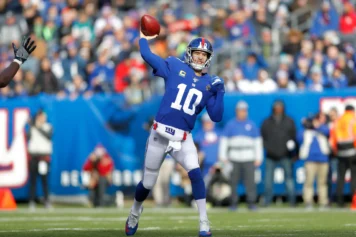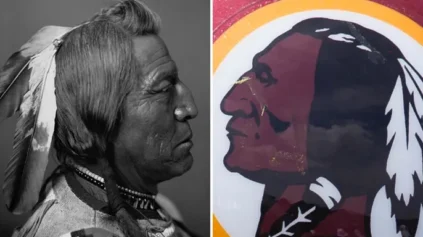The tragic murder of Washington Redskins All-World safety Sean Taylor is a moment in NFL history that most Skins fans suppress in the back of their minds like a molested child now struggling as an adult, to forget the horrors of his past.
Nobody in DC talks much about Taylor or that fateful night on November 26th of 2007 when during a botched home invasion, he was shot in the upper thigh, damaging his femoral artery and leaving him leaking blood until he died.
It’s too painful a memory.
But nights like NFL Thursday, when the Redskins secondary gets lit up for 45 points and four passing TDs by Eli Manning in a nationally-televised, booty-kicking, there are legions of Redskins fans thinking, “that would have never have happened on Sean Taylor’s watch.”
It’s highly unlikely Taylor would’ve allowed second-year tight end Larry Donnell who went undrafted out of Grambling State, to catch three first-half TD’s against his secondary. No receiver was comfortable when Taylor was in the vicinity. Taylor grew up in a low-income neighborhood in Miami, on a street lined with candy-colored houses and blood-stained uniforms. He starred in various Florida high schools and then continued the tradition of a long-line of homegrown defensive studs to attend The University of Miami.
Described as a product of his inescapable environment, Taylor had a laundry list of legal troubles throughout his four-year NFL career: an arrest for DWI, a plea of no contest to misdemeanor assault and battery charges after a confrontation in Miami, an ejection from a playoff game for spitting and a hefty fine for flat-leaving a mandatory rookie symposium.
Aside from his football family, Redskins fans and actual blood ties, most sports prognosticators and analysts classified Taylor as the out of control, crime-affiliated football star whose situation was tragic but not totally unexpected considering his “lifestyle.”
That very perception of Sean Taylor—as an NFL Thug who fell victim to his irreversible thirst for the street life—is what motivated Erik Powers, now a producer in his ninth season with NFL Films (who was in his early 20s when Taylor died and had heard some of the national media chatter — that Taylor’s death was not terribly surprising if you considered how he lived his life) to dig deeper and uncover Taylor’s true story.
It didn’t make sense to him that a guy who was so beloved by the fans could really be a bad due. Two years ago, Powers started pitching the idea of a film about Taylor, as part of NFL Network’s “A Football Life” series.
“That image just sort of stuck with me,” Powers said this week. Taylor “was a man who you didn’t really hear from. He didn’t give interviews. And yet he had this bond with Redskins fans. ”
A year ago, he and NFL Films senior producer Chip Swain began laying the groundwork by interviewing Taylor’s father, and by last March, they were going hard on the project.
Sean Taylor: A Football Life will air at 9pm EST on NFL Network Friday night. Powers attempts to provide a balance to the defensive wizard’s story.
According to the Washington Post, Powers and crew tell the full-scope tale “of a kid who never recovered from being separated from his mother and siblings, whose football career was predicated on a desire to reunite his family. Of a player so devoted to excellence that he would join three separate workout groups at Redskins Park, would leave his car at the park and run home after practice, would do sprints by himself before the rest of the team arrived. Of a father who imprinted his newborn daughter’s footprints on his T-shirt in the delivery room, who was so protective that he blanched at letting even family members hold his young child.”
They interviewed about 35 people — friends, relatives notable football figures, journalists and teammates of Taylor’s — leading to around 50 hours of footage. Former teammates Clinton Portis, Santana Moss, Ed Reed, Ryan Clark and Fred Smoot offered supreme insight and painted a proper picture of their fallen comrade.
"(Powers and Swain) secured grainy highlights from his high school days. Powers watched every network broadcast of every NFL game Taylor played in, identifying the biggest hits, the game-changing turnovers, the athletic wonders. And Powers and Swain wound up with a 44-minute piece that tells a story familiar to many Washington fans, but likely less so outside this market: that Taylor’s public image did not mesh with the private man."
Taylor’s dynamic skill set and the ferocity of his hits, led to several of his Redskins teammates nicknaming him "Meast," a portmanteau word from the expression "half man, half beast." He was slain in beastly fashion as well, but the fact that Taylor was a victim of a vicious plot and not of some suggested criminal lifestyle, puts his memory in a more respectable perspective and credits "Meast" with a legacy that he truly deserves and was enroute to before destiny did its cowardly and inexplicable two-step on his life.
Witnesses say Taylor, who had starred at the University of Miami, was shot when he confronted a group of five young men attempting to—in the words of the legendary Biggie Smalls, who also was assassinated in the prime of his glorious and turmoil-filled career—“kick in the door, waving the .44” and steal some of that baller cash Taylor was known to keep in abundance.
One of the men charged in the slaying, 25-year-old Jason Mitchell, attended a birthday party a few weeks earlier at the house for Taylor's half-sister, Sasha Johnson – who lived in Fort Myers and knew the alleged triggerman Eric Rivera Jr. She testified that Taylor gave her a purse containing $10,000 in cash at the party, which was witnessed by all the guests.
That event inspired thoughts of a burglary plot, witnesses said. Accomplice Rivera himself testified that some in the group thought they would get between $100,000 and $200,000 in the jack, but these amateurs didn't do their homework.
The killers figured Taylor would be on the road with the team, but he was home with his girlfriend and 18-month old baby nursing an injury. When they broke in, Taylor confronted the armed assailants with a machete outside his bedroom. That's when Rivera shot him. A medical examiner said he was essentially dead on arrival at a hospital, although doctors did manage to restart his heart for a while.
Mitchell, the man believed to have masterminded the failed home invasion at Taylor's residence, was convicted of first-degree felony murder and armed burglary, according to the Associated Press.
He was sentenced to life in prison following the conviction, according to the Miami Herald and his sentence came seven months after Rivera was convicted of second-degree murder . Rivera, 23, was sentenced to 57 years in prison for the part he played in Taylor's murder.
Two other defendants await trial — 24-year-old Charles Wardlow and 22-year-old Timothy Brown, and 26-year-old Venjah Hunte previously pleaded guilty.
Taylor, a first-round NFL draft pick in 2004, signed an $18 million contract with the team and was emerging as one of the league’s elite defensive players when he was slain. It was a devastating blow to the Redskins franchise and the Miami-Dade Community. After viewing the film, it’s obvious that the old adage, “ Don’t judge a book by its cover” really applies to Taylor. He inspired teammates, was a good family man and was actually a great example for every football player, and according to legendary Redskins coach Joe Gibbs, a coach’s dream.
That (negative) public perception “was a little bit of my entry point into Sean’s legacy,” Powers said . “I saw that stuff, and honestly, I felt a little guilty for reading that and assuming that Sean was some sort of a thug. If there are people out there who still for whatever reason think that Sean was a certain way, we’re going to lay it out for them: No. This is who he really was.”



